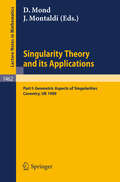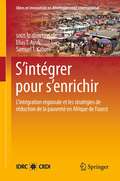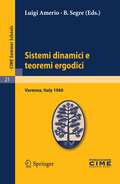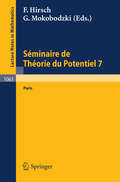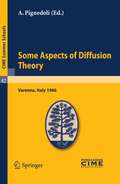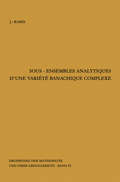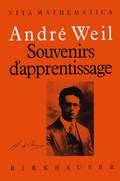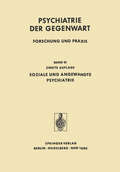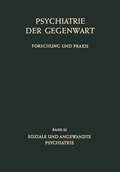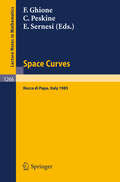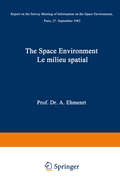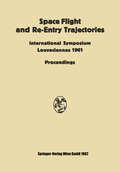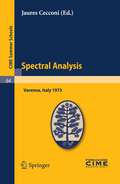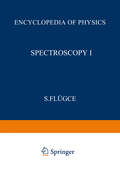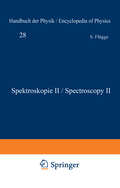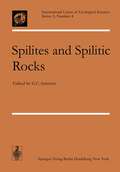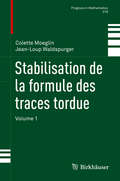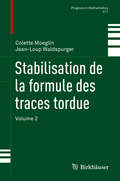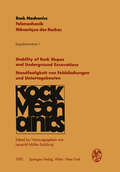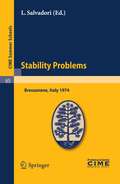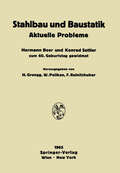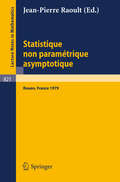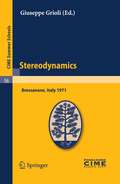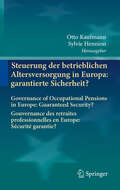- Table View
- List View
Singularity Theory and its Applications: Warwick 1989, Part I: Geometric Aspects of Singularities (Lecture Notes in Mathematics #1462)
by David Mond James MontaldiA workshop on Singularities, Bifurcation and Dynamics was held at Warwick in July 1989 as part of a year-long symposium on Singularity Theory and its applications. The proceedings fall into two halves: Volume I mainly on connections with algebraic geometry and volume II on connections with dynamical systems theory, bifurcation theory, and applications in the sciences. The papers are orginal research, stimulated by the symposium and workshops: All have been refereed, and none will appear elsewhere. The main topic, deformation theory, is represented by several papers on descriptions of the bases of versal deformations, and several more on descriptions of the generic fibres. Other topics include stratifications, and applications to differential geometry.
S’intégrer pour s’enrichir: L’intégration régionale et les stratégies de réduction de la pauvreté en Afrique de l’ouest (Idées et innovation en développement international)
by Elias T. Ayuk and Samuel T. KaboréL’intégration régionale comme premier pas vers l’accès au marché mondial? Dans un contexte où la libéralisation du commerce n'a pas entraîné les gains escomptés par les pays sous-développés et où la croissance du commerce mondial ne s’est pas accompagnée d’une croissance économique équivalente, une solution alternative a émergée. Un nouveau paradigme a fait valoir que la libéralisation des échanges devait s’accompagner d’investissements publics. Cela dit, la nature même de la libéralisation du commerce entraîne une diminution des ressources nécessaires aux investissements publics. Sur la base d’arguments solides, les pays sous-développés sont donc actuellement encouragés à mettre d’abord l’accent sur l'intégration régionale avant de rechercher l’accès au marché mondial. Cet ouvrage, qui aborde les questions liées à l’intégration régionale en Afrique de l’ouest, présente des données empiriques sur les efforts entrepris par les pays de l'Union économique et monétaire ouest-africaine (UEMOA) pour la convergence de leurs économies. Il examine également comment ces efforts, qui représentent un élément important pour l’intégration régionale, influent sur la réduction de la pauvreté dans les pays de l’UEMOA. Il intéressera par conséquent tous les chercheurs qui travaillent sur ce thème.
Sistemi dinamici e teoremi ergodici: Lectures given at a Summer School of the Centro Internazionale Matematico Estivo (C.I.M.E.) held in Varenna (Como), Italy, June 2-11, 1960 (C.I.M.E. Summer Schools #21)
by Luigi Amerio B. SegreLectures: P.R. Halmos: Entropy in ergodic theory.- E. Hopf: Some topics of ergodic theory.- J.L. Massera: Les équations différentielles linéaires dans les espaces de Banach.- Seminars: L. Amerio: Funzioni quasi-periodiche astratte e problemi di propagazione.- L. Markus: Sistemi dinamici con stabilità strutturale.- G. Prodi: Teoremi erodici per le equazioni di idrodinamica.- A.N. Feldzamen: The Alexandra Ionescu-Tulcea proof of McMillan´s theorem.
Sminaire de Theorie du Potentiel Paris, No. 7 (Lecture Notes in Mathematics #1061)
by M. Brelot F. Hirsch G. Choquet G. Mokobodzki J. DenySome Aspects of Diffusion Theory: Lectures given at a Summer School of the Centro Internazionale Matematico Estivo (C.I.M.E.) held in Varenna (Como), Italy, September 9-27,1966 (C.I.M.E. Summer Schools #42)
by A. PignedoliV.C.A. Ferraro: Diffusion of ions in a plasma with applications to the ionosphere.- P.C. Kendall: On the diffusion in the atmosphere and ionosphere.-F. Henin: Kinetic equations and Brownian motion.- T. Kahan:Théorie des réacteurs nucléaires: méthodes de résolution perturbationnelles, interactives et variationnelles.- C. Cattaneo: Sulla conduzione del calore.- C. Agostinelli: Formule di Green per la diffusione del campo magnetico in un fluido elettricamente conduttore.- A. Pignedoli: Transformational methods applied to some one-dimensional problems concerning the equations of the neutron transport theory.- A. Pignedoli: On the rigorous analysis of the problem of neutron transport in a slab geometry and on some other results.- G. Sestini: Principi di massimo per le soluzioni di equazioni paraboliche.
Sous-ensembles analytiques d'une variete banachique complexe (Ergebnisse der Mathematik und ihrer Grenzgebiete. 2. Folge #53)
by Jean-Pierre RamisThis book gives an exposition of A. Douady's works in the theory of Banach analytic varieties.
Souvenirs d'apprentissage (Vita Mathematica #6)
by André WeilL’auteur, mathématicien, mais dont l‘horizon ne s‘est jamais borné aux mathématiques, évoque ici les souvenirs d’une carrière qui l’a mené dans plusieurs continents : Italie et Allemagne d’abord, puis l’Inde où il séjourna et enseigna à une époque décisive pour l’histoire de ce pays, et où il rencontra brièvement Ghandi, et plus longuement Jawaharlal Nehru ; l’U.R.S.S., à un moment où le stalinisme semblait se relâcher avant de rependre bientôt en toute férocité ; Princeton, le « clearing house » moderne des idées mathématiques, dit parfois le paradis des mathématiciens ; la prison, en Finlande, où, pris pour un espion soviétique, il manqua de peu le poteau d’exécution, puis en France où il fut condamné pour avoir tenté de se soustraire à ses obligations militaires, et où il eut le temps de rédiger à la prison de Rouen l’un de ses meilleurs travaux mathématiques ; l’Angleterre où il vécut la bataille de Londres avant de se retrouver en France et d’en repartir pour l’Amérique ; le Brésil enfin, terme de ses vicissitudes. A travers ces épisodes souvent pittoresques s’est déroulé un destin de mathématicien dont l’un des points saillants fut sa participation à la fondation du groupe Bourbaki, auteur collectif d’un traité déjà devenu classique.
Soziale und Angewandte Psychiatrie (Psychiatrie der Gegenwart #3)
by H. ArgelanderDie erste Auflage dieses Bandes "Soziale und angewandte Psychiatrie" er schien 1961. Seither wurden die Wechselwirkungen zwischen dem gesellschaft lichen Feld und der Psychiatrie intensiver und weiter. Die Sozietiit fordert und uberfordert die Psychiatrie, und umgekehrt scheint es iihnlich zu sein. Der Be griff "Sozialpsychiatrie" wird strapaziert, indem er fiir soziologische und epide miologische Forschung, aber auch fiir moderne gemeindenahe Therapieformen verwandt wird. Diesseits von klinischem und soziologischem Dogmatismus ist Psychiatrie sozial, wenn sie in ihre Theorie und Praxis die Beziehung zwischen Individuellem und Transindividuellem (soweit dieses nicht rein biologisch be stimmt ist) aufnimmt. Sozialpsychiatrie ist keine modische Rivalin einer klinischen Psychiatrie, die mit ihr nun zu wetteifern hiitte. Sie ist auch keine Gegen Psychiatrie sondern Psychiatrie in gesellschaftlicher Perspektive. Daher halten die Herausgeber mit Bedacht am alten Titel des Buches fest: Psychiatrie wird, wo sie vollen Sinn gewinnt, notwendig eine "soziale" und "ange wandte" sein. Wir wollen die Psychiatrie nicht als eine Bindestrich-Disziplin an zeitgebundene Stromungen der Theorie oder Praxis der Sozialwissenschaften knupfen. Dieser Band legt einerseits das Gewicht auf Methoden und Ergebnisse gesellschaftsbezogener empirischer Forschung in der Psychiatrie, andererseits auf die institutionellen und therapeutischen Dienste in der gesellschaftsbezogenen psychiatrischen Praxis. Es wurde einmal gesagt, soziale Psychiatrie sei nichts anderes als umfassend verstandene klinische und poliklinische Psychiatrie. In solchem Sinne steht dieser Band III der Psychiatrie der Gegenwart in engem Zusammenhang zu den klinischen Biinden I und II der Zweitauflage.
Soziale und angewandte Psychiatrie (Psychiatrie der Gegenwart #3)
by E. K. CruickshankDer dritte Band dieses Werkes spiegelt, vielleicht mehr noch als der Grund lagenteil und die klinischen Abschnitte, entscheidende Wandlungen der Psych iatrie der Gegenwart wider: Ablösung der Psychiatrie von ihrer Ursprungsstätte, dem psychiatrischen Krankenhaus, ihr Einströmen nicht nur in fachliche Grenz gebiete, sondern ins öffentliche Bewußtsein, und die Verlagerung der praktischen psychiatrischen Tätigkeit extra muros. Manche Beiträge behandeln Stoffgebiete, die in keinem früheren Hand- oder Lehrbuch der Psychiatrie erwähnt sind und vor 20 oder 30 Jahren auch noch nicht hätten geschrieben werden können. In einer ersten Gruppe von Beiträgen zur praktischen und sozialen Psychiatrie wird diese Wandlung besonders spürbar. Es lag den Herausgebern daran, hier neuen Ansichten und Bestrebungen Raum zu gewähren, die Problematik der vielfach durch aus noch im Flusse befindlichen Konzeptionen klarzustellen, ihre Vielfalt zu gliedern und zu ordnen und die Verbindungen mit den Nachbargebieten der Psychologie, Heilpädagogik, Sozialwissenschaft, Legislatur, Strafvollzug usw. zu verfolgen. Ein einleitender Abschnitt über die neueren Strömungen in der praktischen Psychiatrie behandelt in die Zukunft weisende Auffassungen über die Organisation und die baulichen Probleme des psychiatrischen Krankenhauses und des ambulan ten psychiatrischen Dienstes. Endgültige Lösungen sind noch nicht gefunden, die Richtung der nächsten Entwicklung wird aber deutlich sichtbar. Die soziale Psychiatrie befaßt sich mit den Einflüssen der Sozialstruktur auf die Entstehung und den Verlauf seelischer Störungen, mit der Stellung des psychisch kranken Menschen innerhalb der Gesellschaft, mit der Frage seiner Hospitalisations bedürftigkeit usw. , während der seelische Gesundheitsschutz die präventiven Maßnahmen für die gesunde Bevölkerung im Auge hat.
Space Curves: Proceedings of a Conference held in Rocca di Papa, Italy, June 3-8, 1985 (Lecture Notes in Mathematics #1266)
by Franco Ghione Christian Peskine Edoardo SernesiThe main topics of the conference on "Curves in Projective Space" were good and bad families of projective curves, postulation of projective space curves and classical problems in enumerative geometry.
The Space Environment / Le Milieu Spatial: Report on the Survey Meeting of Information on the Space Environment Paris, 27 September 1963
by Alfred EhmertOrganized by the International Academy of Astronautics and the International Astronautical Federation with the Support and Cooperation of UNESCO and the Scientific Cooperation of COSPAR
Space Flight and Re-Entry Trajectories: International Symposium Organized by the International Academy of Astronautics of the IAF Louveciennes, 19–21 June 1961 Proceedings
by Paul A. LibbyIn this and a following issue (Vol. VIII, 1962, Fasc. 2-3) of "Astronautica Acta" there will appear the papers presented at the first international symposium sponsored by the International Academy of Astronautics of the International Astronautical Federation. The theme of the meeting was "Space Flight and Re-Entry Trajectories." It was held at Louveciennes outside of Paris on June 19-21, 1961. Sixteen papers by authors from nine countries were presented; attendees numbered from 80 to 100. The organizing committee for the symposium was as follows: Prof. PAUL A. LIBBY, Polytechnic Institute of Brooklyn, U.S.A., Chairman; Prof. LuiGI BROGLIO, University of Rome, Italy; Prof. B. FRAEIJS DE VEUBEKE, University of Liege, Belgium; Dr. D. G. KING-HELE, Royal Aircraft Establishment, Farnborough, Rants, United Kingdom; Prof. J. M. J. KooY, Royal Military School, Breda, Netherlands; Prof. JEAN KovALEVSKY, Bureau des Longitudes, Paris, France; Prof. RuDOLF PESEK, Academy of Sciences, Prague, Czechoslovakia. The detailed arrangements for the meeting were made in a most satisfactory manner by Dr. FRANK J. MALINA, Deputy Director of IAA and Mr. A. R. WEILLER, Acting Secretary of IAA. Prof. THEODORE VON KARMAN, Director of IAA, in his remarks closing the symposium indicated his satisfaction at the interest being shown in "the science of the future." The papers which follow will make a permanent contribution to the literature of this science.
Spectral Analysis: Lectures given at a Summer School of the Centro Internazionale Matematico Estivo (C.I.M.E.) held in Varenna (Como), Italy, August 24-September 2, 1973 (C.I.M.E. Summer Schools #64)
by Jaures CecconiG. Bottaro: Quelques résultats d’analyse spectrale pour des opérateurs différentiels à coefficients constants sur des domaines non bornés.- L. Gårding: Eigenfuction expansions.- C. Goulaouic: Valeurs propres de problèmes aux limites irréguliers: applications.- G. Grubb: Essential spectra of elliptic systems on compact manifolds.- J.Cl. Guillot: Quelques résultats récents en Scattering.- N. Schechter: Theory of perturbations of partial differential operators.- C.H. Wilcox: Spectral analysis of the Laplacian with a discontinuous coefficient.
Spektroskopie II / Spectroscopy II (Handbuch der Physik Encyclopedia of Physics #5 / 28)
by S. FlüggeSpilites and Spilitic Rocks (International Union of Geological Sciences #4)
by G. C. AmstutzThe idea for the present Spilite Volume was born during the Spilite Symposium at the XXIIIrd session of the International Geological Con gress in Prague, 1968. At that time, only a restricted number of petro logists working on spilites was present and, therefore, the group assem bled agreed that a Symposium Volume should also include recent papers by many other spilite specialists. At the same time it was agreed that the papers presented at the Symposium should be returned to the authors for changes and additions. This procedure of upgrading and amending the papers has continued until this year (1973) for various technical and editorial reasons. The information presented here is, therefore, up-to date. To those familiar with the spilite problem it is obvious that the time had come for a review of its state. Also, the existing litera ture had become so voluminous that a monographic review was necessary. Following a modern trend, the authorship for this review was spread among specialists with variable experience. For readers not necessarily familiar with the spilite problem, a brief summary is presented here. A short historical note is followed first by the observations, then by the interpretations, finally by some of the major features of scientific logic as they pertain to the problem of the primary or secondary origin of some of the rocks termed spilites and keratophyres.
Split the Sun: An Inherit The Stars Novel
by Tessa ElwoodThe Ruling Lord of the House of Galton is dead and the nation is divided. Kit Franks, a nobody escalated to infamy since her mother bombed the House capitol city, wishes she were dead, too. Then Mom-the-terrorist starts showing up on feeds and causing planet-wide blackouts and Kit becomes a target. Kit's inundated with half-truths, betrayals, and the coded subtext in Mom's universal feed messages meant for her alone. Everyone from family to government enforcers seems to have a vision for Kit's future. The question is, does Kit have a vision for herself?
Stabilisation de la formule des traces tordue: Volume 1 (Progress in Mathematics #316)
by Colette Moeglin Jean-Loup WaldspurgerCe travail en deux volumes donne la preuve de la stabilisation de la formule des trace tordue.Stabiliser la formule des traces tordue est la méthode la plus puissante connue actuellement pour comprendre l'action naturelle du groupe des points adéliques d'un groupe réductif, tordue par un automorphisme, sur les formes automorphes de carré intégrable de ce groupe. Cette compréhension se fait en réduisant le problème, suivant les idées de Langlands, à des groupes plus petits munis d'un certain nombre de données auxiliaires; c'est ce que l'on appelle les données endoscopiques. L'analogue non tordu a été résolu par J. Arthur et dans ce livre on suit la stratégie de celui-ci.Publier ce travail sous forme de livre permet de le rendre le plus complet possible. Les auteurs ont repris la théorie de l'endoscopie tordue développée par R. Kottwitz et D. Shelstad et par J.-P. Labesse. Ils donnent tous les arguments des démonstrations même si nombre d'entre eux se trouvent déjà dans les travaux d'Arthur concernant le cas de la formule des traces non tordue.Ce travail permet de rendre inconditionnelle la classification que J. Arthur a donnée des formes automorphes de carré intégrable pour les groupes classiques quasi-déployés, c’était pour les auteurs une des principales motivations pour l’écrire.Cette première partie comprend les chapitres préparatoires (I-V).
Stabilisation de la formule des traces tordue: Volume 2 (Progress in Mathematics #317)
by Colette Moeglin Jean-Loup WaldspurgerCe travail en deux volumes donne la preuve de la stabilisation de la formule des trace tordue. Stabiliser la formule des traces tordue est la méthode la plus puissante connue actuellement pour comprendre l'action naturelle du groupe des points adéliques d'un groupe réductif, tordue par un automorphisme, sur les formes automorphes de carré intégrable de ce groupe. Cette compréhension se fait en réduisant le problème, suivant les idées de Langlands, à des groupes plus petits munis d'un certain nombre de données auxiliaires; c'est ce que l'on appelle les données endoscopiques. L'analogue non tordu a été résolu par J. Arthur et dans ce livre on suit la stratégie de celui-ci. Publier ce travail sous forme de livre permet de le rendre le plus complet possible. Les auteurs ont repris la théorie de l'endoscopie tordue développée par R. Kottwitz et D. Shelstad et par J.-P. Labesse. Ils donnent tous les arguments des démonstrations même si nombre d'entre eux se trouvent déjà dans les travaux d'Arthur concernant le cas de la formule des traces non tordue. Ce travail permet de rendre inconditionnelle la classification que J. Arthur a donnée des formes automorphes de carré intégrable pour les groupes classiques quasi-déployés, c’était pour les auteurs une des principales motivations pour l’écrire. Cette partie contient les preuves de la stabilisation géométrique et de la partie spectrale en particulier de la partie discrète de ce terme, ce qui est le point d'aboutissement de ce sujet.
Stability of Rock Slopes and Underground Excavations / Standfestigkeit von Felsböschungen und Untertagebauten: Contributions to the Josef-Stini-Colloquium (18th Geomechanical Colloquium) of the Austrian Society for Geomechanics / Vorträge des Josef-Stini-Kolloquiums (18. Geomechanik-Kolloquium) der Österreichischen Gesellschaft für Geomechanik (Rock Mechanics Felsmechanik Mecanique des roches. Supplementa #1)
by Leopold MüllerStability Problems: Lectures given at a Summer School of the Centro Internazionale Matematico Estivo (C.I.M.E.) held in Bressanone (Bolzano), Italy, June 2-11, 1974 (C.I.M.E. Summer Schools #65)
by L. SalvadoriP. Habets: Stabilité asymptotique pour des problèmes de perturbations singulières.- J.K. Hale: Stability of linear systems with delays.- V. Lakshmikantham: Stability and asymptotic behaviour of solutions of differential equations in a Banach space.- P. Negrini: On a definition of total stability for continuous or discrete dynamical systems.-N. Rouche: Théorie de la stabilité dans les équations différentielles ordinaires.- E.O. Roxin: Stability and differential games.
Stahlbau und Baustatik: Aktuelle Probleme
by Hermann Grengg Walter Pelikan F. ReinitzhuberHermann Beer und Konrad Sattler zum 60. Geburtstag gewidmet
Statistique non Parametrique Asymptotique: Actes des Journees Statistiques, Rouen, France, Juin 1979 (Lecture Notes in Mathematics #821)
by J. P. RaoultStereodynamics: Lectures given at a Summer School of the Centro Internazionale Matematico Estivo (C.I.M.E.) held in Bressanone (Bolzano), Italy, June 2-12, 1971 (C.I.M.E. Summer Schools #56)
by Giuseppe GrioliG. Grioli: Particular solutions in stereodynamics.- P. Hagedorn: On the converse of the Lagrange-Dirichlet stability theorem.- M. Langlois: Contribution à l’étude du mouvement du corps rigide à n dimensions autour d’un point fixe.- E. Leimanis: Some recent results concerning the motion of a rigid body about a fixed point.- H. Price: A canonical form of Euler’s equations and a method of solutions for arbitrary applied couples.- V.V. Rumyentsev: Dynamics and stability of rigid bodies.- J. Wittenburg: The dynamics of systems of coupled rigid bodies. A new general formalism with applications.
Steuerung der betrieblichen Altersversorgung in Europa: Governance of Occupational Pensions in Europe: Guaranteed Security? Gouvernance des retraites professionnelles en Europe: Sécurité garantie?
by Otto Kaufmann and Sylvie HennionNahezu alle europäischen Staaten haben ihre Alterssicherungssysteme reformiert mit dem Ziel, sie zu konsolidieren. Die betriebliche Altersversorgung ist seitdem zu einem Schwerpunkt betrieblicher Sozialpolitik geworden. Bei der Errichtung, Durchführung und der Kontrolle betrieblicher Altersversorgungssysteme stellen sich zahlreiche Rechtsfragen. In dem Werk wird das Zusammenwirken der Sozialpartner analysiert. Es wird aufgezeigt, welche Handlungsspielräume bestehen und welche Kontroll- und Entscheidungskompetenzen jeweils eingeräumt werden.
